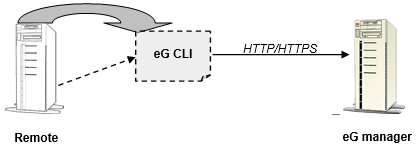How does the eG CLI Work?
The eG CLI is currently supported on Windows, Linux, and Solaris environments.
By default, the eG CLI is bundled with the eG manager. Accordingly, once the eG manager is installed, the CLI-related files automatically get installed into the <EG_INSTALL_DIR>\egcli directory (on Windows; on Unix, this will be the /opt/egurkha/egcli directory). You can then proceed to issue the CLI commands from the Windows command prompt / Unix shell prompt on the eG manager host, and easily administer the eG Enterprise system.
On the other hand, to install eG CLI on a remote Windows/Linux/Solaris host, you will have to run a special set-up program that is provided. This is called eGCLI.exe on Windows environments, iCLI_linux on Linux and iCLI_solaris on Solaris. If an automation tool is in use in your environment, the setup program has to be executed on the host on which the automation tool (say, HPOO) operates. On the other hand, if no orchestration engine is in use in your environment, then, you can run the setup program on any remote host in your environment, so that eG CLI gets installed on that host.
Once installed, you need to configure the CLI to access the eG manager in the target environment, so that the CLI can execute commands/scripts on it to setup the environment for monitoring.

Figure 3 : How the eG CLI works
In a redundant eG manager setup on the other hand, the eG CLI should be configured to communicate with the primary manager alone, as administrative operations can be performed only on this manager. Once this is done, the redundant manager architecture will ensure that the configuration changes effected on the primary manager are automatically replicated to the secondary manager(s).
To know how to install and configure the eG CLI, refer to the Installing and Configuring the eG CLI document. Once the eG CLI is installed and configured, you can begin executing the eG CLI commands discussed in the next chapter.
